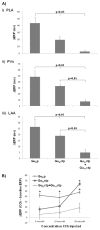Targeted nonviral gene-based inhibition of Gα(i/o)-mediated vagal signaling in the posterior left atrium decreases vagal-induced atrial fibrillation
- PMID: 21689540
- PMCID: PMC3570566
- DOI: 10.1016/j.hrthm.2011.06.018
Targeted nonviral gene-based inhibition of Gα(i/o)-mediated vagal signaling in the posterior left atrium decreases vagal-induced atrial fibrillation
Abstract
Background: Pharmacologic and ablative therapies for atrial fibrillation (AF) have suboptimal efficacy. Newer gene-based approaches that target specific mechanisms underlying AF are likely to be more efficacious in treating AF. Parasympathetic signaling appears to be an important contributor to AF substrate.
Objective: The purpose of this study was to develop a nonviral gene-based strategy to selectively inhibit vagal signaling in the left atrium and thereby suppress vagal-induced AF.
Methods: In eight dogs, plasmid DNA vectors (minigenes) expressing Gα(i) C-terminal peptide (Gα(i)ctp) was injected in the posterior left atrium either alone or in combination with minigene expressing Gα(o)ctp, followed by electroporation. In five control dogs, minigene expressing scrambled peptide (Gα(R)ctp) was injected. Vagal- and carbachol-induced left atrial effective refractory periods (ERPs), AF inducibility, and Gα(i/o)ctp expression were assessed 3 days following minigene delivery.
Results: Vagal stimulation- and carbachol-induced effective refractory period shortening and AF inducibility were significantly attenuated in atria receiving a Gα(i2)ctp-expressing minigene and were nearly eliminated in atria receiving both Gα(i2)ctp- and Gα(o1)ctp-expressing minigenes.
Conclusion: Inhibition of both G(i) and G(o) proteins is necessary to abrogate vagal-induced AF in the left atrium and can be achieved via constitutive expression of Gα(i/o)ctps expressed by nonviral plasmid vectors delivered to the posterior left atrium.
Copyright © 2011 Heart Rhythm Society. Published by Elsevier Inc. All rights reserved.
Figures




Comment in
-
Gene therapy for AF: A dream too far?Heart Rhythm. 2011 Nov;8(11):1730-1. doi: 10.1016/j.hrthm.2011.07.001. Epub 2011 Jul 6. Heart Rhythm. 2011. PMID: 21740886 No abstract available.
References
-
- Benjamin EJ, Levy D, Vaziri SM, D’Agostino RB, Belanger AJ, Wolf PA. Independent risk factors for atrial fibrillation in a population-based cohort. The Framingham Heart Study. JAMA. 1994;271:840–844. - PubMed
-
- Dobrev D, Nattel S. New antiarrhythmic drugs for treatment of atrial fibrillation. Lancet. 2010;375:1212–1223. - PubMed
-
- Sturrock A, Cahill B, Norman K, et al. Transforming growth factor-β1 induces Nox4 NAD(P)H oxidase and reactive oxygen species-dependent proliferation in human pulmonary artery smooth muscle cells. Am J Physiol Lung Cell Mol Physiol. 2006;290:L661–L673. - PubMed
-
- Sharifov OF, Fedorov VV, Beloshapko GG, Glukhov AV, Yushmanova AV, Rosenshtraukh LV. Roles of adrenergic and cholinergic stimulation in spontaneous atrial fibrillation in dogs. J Am Coll Cardiol. 2004;43:483–490. - PubMed
Publication types
MeSH terms
Substances
Grants and funding
LinkOut - more resources
Full Text Sources
Other Literature Sources
Medical

